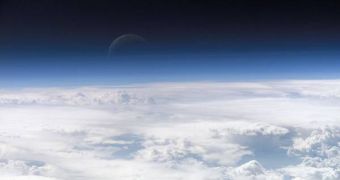We all know that outer space is beyond Earth, but at what precise height it begins exactly has been a subject of intense debate among astronomers until now. Some have tried to find arbitrary definitions, such as the limit of the upper layers of our atmosphere, while others have pressed for a commonly decided limit. In order to settle the squabble, the Canadian space agency decided to take matters into its own hands in 2007, when it launched an observation instrument high into the atmosphere, in order to detect the boundary that separated the Earth from the space around it.
The tool was named the Supra-Thermal Ion Imager, and it was launched aboard a JOULE-II delivery system on January 19th, 2007. What made this scientific flight so special was the fact that the craft took most of its readings at an altitude of about 200 kilometers above the surface of the Earth.
This height was very poorly explored in the past, on account of the fact that it was too large for balloons to reach, and also too low for satellites to remain stable on an orbit. The STII instrument itself only flew at this height for about five minutes, before its flight path decayed.
After analyzing the data that the mission brought back, experts at the University of Calgary have concluded that space begins 118 km above Earth. Their results have been published in this week's edition of the Journal of Geophysical Research. In the end, it only took a $422,000 investment in this science project to yield the answer to the debated question. A NASA facility in Alaska was in charge of the launch and recovery procedures, which concluded without a hitch.
“It's only the second time that direct measurements of charged particle flows have been made in this region, and the first time all the ingredients – such as the upper atmospheric winds – have been included. When you drag a heavy object over a surface, the interface becomes hot. In JOULE-II we were able to measure directly two regions being dragged past each other, one being the ionosphere – being driven by flows in space – and the other the earth's atmosphere,” University of Calgary Department of Physics and Astronomy Associate Professor David Knudsen explains. He is also the head of the Institute for Space Imaging Sciences (ISIS) Space Physics Division.
“Understanding the boundary between the Earth's atmosphere and outer space is fundamental to the bigger picture of the effects of space on the Earth's climate and environment. This detection is part of a long history of success by ISIS researchers in designing and building innovative instruments flown on rockets and satellites to image the flow of matter and energy between the Earth and Space,” ISIS Director Russ Taylor, who is also the head of the UC Department of Physics and Astronomy, concludes.

 14 DAY TRIAL //
14 DAY TRIAL //